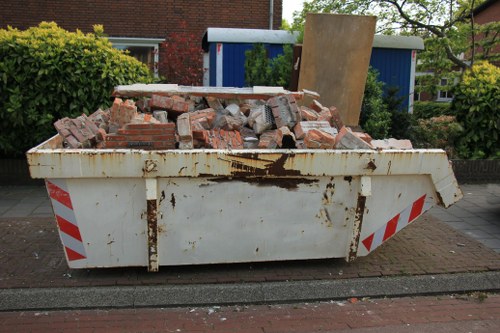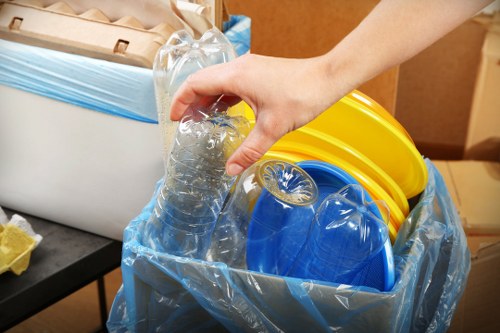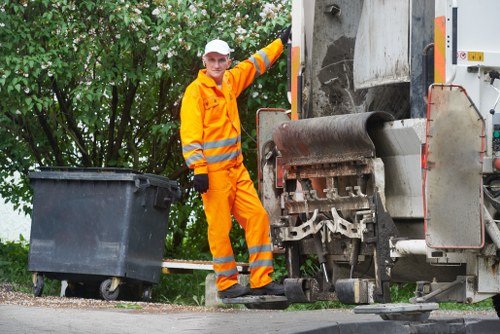Waste Collection in Furniture Disposal

Importance of Proper Furniture Disposal
Proper waste collection in furniture disposal is crucial for maintaining environmental sustainability and public health. Furniture items, when discarded irresponsibly, can lead to significant ecological damage and pose health risks to communities. Ensuring that furniture waste is managed effectively minimizes the negative impact on our planet.
Moreover, efficient waste collection systems help in the conservation of natural resources. By recycling and reusing furniture materials, we reduce the need for raw material extraction, thereby preserving forests and decreasing energy consumption. This not only benefits the environment but also supports economic sustainability.
Additionally, proper furniture disposal contributes to the aesthetic and hygiene of urban and residential areas. Accumulated waste can lead to cluttered spaces, attracting pests and creating unsanitary conditions. Organized waste collection ensures cleaner and healthier living environments for everyone.

Environmental Impact
Furniture disposal has a direct impact on the environment. Many furniture pieces contain materials such as wood, metal, and plastics, which, if not disposed of correctly, can lead to soil and water contamination. Chemicals used in furniture manufacturing, like varnishes and adhesives, can leak into ecosystems, harming wildlife and plant life.
Landfills are the primary destination for discarded furniture, but they are not a sustainable solution. Landfills consume vast amounts of land and contribute to greenhouse gas emissions, exacerbating climate change. Proper waste collection and recycling can significantly mitigate these environmental threats by reducing the volume of waste that ends up in landfills.
Furthermore, recycling furniture materials conserves energy and reduces carbon footprints. For instance, recycling wood requires less energy compared to producing new wood products from trees. This energy efficiency plays a vital role in combating global warming and promoting a greener future.

Health and Safety Concerns
Improper furniture disposal can pose serious health and safety risks. Broken or sharp-edged furniture items can cause injuries during handling and transportation. Additionally, large furniture pieces can create obstacles in public spaces, increasing the risk of accidents and hindering emergency response efforts.
Burning furniture waste is another significant health hazard. The combustion process releases toxic fumes and particulate matter into the air, contributing to respiratory problems and other health issues for nearby populations. Safe disposal methods are essential to prevent such harmful emissions.
Moreover, cluttered disposal sites can become breeding grounds for pests and vermin, leading to the spread of diseases. Maintaining clean and organized waste collection systems helps in minimizing these health risks and ensures safer communities.

Methods of Furniture Disposal
There are several effective methods for furniture disposal, each with its own set of benefits and processes. Understanding these methods helps individuals and organizations choose the most sustainable and efficient option for their needs.
One of the primary methods is recycling and reuse. Furniture that is still in good condition can be refurbished and used again, extending its lifecycle and reducing the demand for new products. Recycling involves breaking down furniture items into their constituent materials, which can then be repurposed for new manufacturing projects.
Donation programs are another popular method of furniture disposal. Charitable organizations often accept gently used furniture, providing those in need with essential items while diverting waste from landfills. This method not only supports social causes but also promotes a circular economy.

Recycling and Reuse
Recycling and reusing furniture are environmentally friendly options that contribute to waste reduction. By repurposing materials such as wood, metal, and fabric, we decrease the need for extracting new resources and limit the environmental footprint of furniture production.
Many communities offer specialized recycling programs for furniture, making it easier for residents to dispose of items responsibly. These programs often involve collection services or drop-off points where furniture can be sorted and processed for recycling.
Moreover, businesses focused on upcycling furniture are gaining popularity. They creatively transform old or discarded pieces into unique, functional items, adding value and aesthetic appeal while promoting sustainability.
Donation Programs
Donation programs play a significant role in furniture disposal by providing an avenue for individuals to give their unwanted items a second life. Organizations such as Goodwill, Salvation Army, and local charities regularly accept furniture donations, which are then distributed to those in need or sold to fund community programs.
Participating in donation programs not only helps reduce waste but also supports social welfare initiatives. It fosters a sense of community and encourages responsible consumption by promoting the reuse of valuable resources.
Additionally, donating furniture can offer financial benefits to donors, including tax deductions. This incentive makes it a win-win situation for both the environment and individuals looking to declutter responsibly.
Professional Waste Collection Services
Professional waste collection services specialize in the efficient and safe removal of furniture waste. These services offer tailored solutions to meet the specific needs of residential and commercial clients, ensuring that furniture is disposed of in compliance with environmental regulations.
These companies typically provide comprehensive services, including the pickup, transportation, and disposal of furniture items. They are equipped with the necessary tools and expertise to handle large or bulky items, minimizing the hassle for clients.
Moreover, professional waste collection services often implement recycling and donation practices as part of their operations. This ensures that a significant portion of the collected furniture is diverted from landfills, contributing to sustainability goals.
Waste Collection Process
The waste collection process for furniture disposal involves several key steps designed to ensure efficiency and environmental responsibility. Understanding this process helps individuals and businesses navigate furniture disposal with ease.
Scheduling a collection is the first step in the waste collection process. Clients can arrange for a pickup time that suits their schedule, often through online platforms or customer service channels. Professional waste collection services offer flexible scheduling to accommodate varying needs.
Once scheduled, the collection team arrives at the designated location to assess and handle the furniture items. They ensure that items are ready for transport, which may involve disassembling or preparing them to fit into their vehicles safely.
Sorting and Processing
After collection, the furniture items undergo sorting and processing. Recycling centers evaluate each piece to determine if it can be refurbished, recycled, or needs to be disposed of as waste. Materials are separated accordingly, ensuring that recyclables are processed efficiently.
Any items deemed unsuitable for reuse are responsibly disposed of in compliance with local regulations. This meticulous sorting process helps maximize the recyclability of materials and minimize the environmental impact of furniture disposal.
Overall, the waste collection process emphasizes sustainability and efficiency, promoting responsible furniture disposal practices that benefit both individuals and the broader community.
Best Practices for Efficient Waste Collection
Adopting best practices in waste collection ensures that furniture disposal is conducted smoothly and sustainably. Implementing these practices can lead to more efficient operations and better environmental outcomes.
Preparing furniture for disposal is one such best practice. This involves cleaning the items, removing any hazardous materials, and disassembling large pieces to facilitate transportation and processing.
Choosing the right waste collection service is equally important. Evaluating services based on their recycling rates, compliance with environmental standards, and customer reviews can help individuals and businesses select a service that aligns with their sustainability goals.
Preparing Furniture for Disposal
Proper preparation of furniture before disposal involves several steps. Clean the items to remove any dirt or debris, making them more appealing for reuse or recycling. Remove non-recyclable components, such as cushions or electronics, to streamline the recycling process.
Disassembling large furniture pieces can also facilitate easier handling and transport. This reduces the risk of damage during collection and ensures that materials are processed correctly.
Additionally, labeling items with information about their materials or condition can aid waste collection teams in sorting and processing efficiently.
Choosing the Right Waste Collection Service
Selecting a reputable waste collection service is crucial for effective furniture disposal. Look for services that prioritize recycling and have transparent processes for handling waste. Certifications or affiliations with environmental organizations can indicate a commitment to sustainable practices.
Consider the range of services offered, such as same-day pickup, bulk item removal, and specialized handling for delicate or valuable furniture. A versatile service can better accommodate diverse disposal needs.
Lastly, assess customer support and responsiveness. A service that communicates clearly and promptly addresses concerns will provide a smoother disposal experience.
Challenges in Furniture Waste Collection
Despite advancements in waste collection methods, several challenges persist in the realm of furniture disposal. Addressing these challenges is essential for improving waste management systems and promoting sustainability.
Logistical issues often complicate furniture waste collection. The size and weight of furniture items make transportation difficult, especially in densely populated areas with limited access. Ensuring that collection vehicles can navigate various environments is a constant challenge for waste management services.
Additionally, coordinating collection schedules to match client availability without disrupting daily activities requires meticulous planning and resource allocation.
Regulatory Compliance
Regulatory compliance is another significant challenge in furniture waste collection. Different regions have varying laws and guidelines governing waste disposal, recycling, and environmental protection. Navigating these regulations ensures that waste collection services operate legally and ethically.
Non-compliance can lead to hefty fines, legal repercussions, and damage to a company's reputation. Therefore, staying informed about relevant laws and implementing compliant practices is vital for waste collection providers.
Moreover, evolving regulations necessitate continuous adaptation and training for waste management personnel to maintain compliance and uphold environmental standards.
Addressing Challenges
To overcome logistical challenges, waste collection services can invest in specialized equipment designed for handling large and heavy items. Training staff in efficient handling techniques can also minimize transportation difficulties.
Collaborating with local authorities and communities can facilitate smoother operations. Building partnerships ensures better coordination and adherence to regional regulations.
Innovative solutions, such as leveraging technology for route optimization and scheduling, can enhance efficiency and reduce operational hurdles in furniture waste collection.
Future Trends in Furniture Waste Collection
The landscape of furniture waste collection is continually evolving, driven by technological advancements and a growing emphasis on sustainability. Future trends promise to enhance the efficiency and effectiveness of furniture disposal practices.
Technological advancements, such as automation and data analytics, are set to revolutionize waste collection. Automated sorting systems can increase the accuracy and speed of processing recyclable materials, while data analytics can optimize collection routes and schedules, reducing fuel consumption and operational costs.
Moreover, digital platforms facilitating online scheduling, tracking, and service customization will improve the overall user experience, making furniture disposal more convenient and accessible.
Sustainable Practices
There is a growing trend towards implementing more sustainable practices in furniture waste collection. This includes increasing the recycling rates of collected materials, promoting upcycling initiatives, and reducing the carbon footprint of collection services.
Adopting circular economy principles, where furniture is designed for longevity, recyclability, and easy disassembly, can significantly impact waste reduction efforts. Encouraging manufacturers to embrace sustainable design practices complements waste collection efforts by minimizing waste generation at the source.
Furthermore, integrating renewable energy sources into waste collection operations, such as electric collection vehicles, can contribute to greener and more sustainable disposal practices.
Community Engagement and Education
Future trends also emphasize the importance of community engagement and education in improving furniture waste collection. Raising awareness about the benefits of proper disposal, recycling, and donation programs encourages more individuals to participate actively in waste management efforts.
Educational campaigns and community initiatives can foster a culture of sustainability, where responsible furniture disposal becomes a shared responsibility. Engaging with schools, local organizations, and businesses can amplify the impact of these efforts, leading to broader societal change.
In conclusion, the future of furniture waste collection is promising, with innovations and sustainable practices paving the way for more efficient and environmentally friendly disposal methods.
Conclusion
Effective waste collection in furniture disposal is a multifaceted process that plays a critical role in environmental conservation and public health. By understanding the importance, methods, and challenges associated with furniture waste management, individuals and organizations can contribute to more sustainable and responsible disposal practices.
Embracing recycling and reuse, participating in donation programs, and utilizing professional waste collection services ensures that furniture waste is handled efficiently and ethically. Implementing best practices and staying informed about regulatory requirements further enhances the effectiveness of waste collection efforts.
As we look to the future, technological advancements and sustainable practices will continue to transform the landscape of furniture waste management. By fostering community engagement and prioritizing environmentally friendly solutions, we can create a cleaner, healthier, and more sustainable world for generations to come.
Contact us today to learn more about our furniture waste collection services and how we can help you dispose of your furniture responsibly.
Book your service now and take a step towards a greener future.